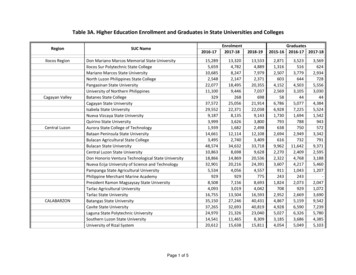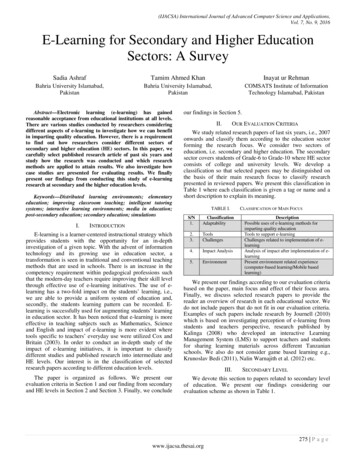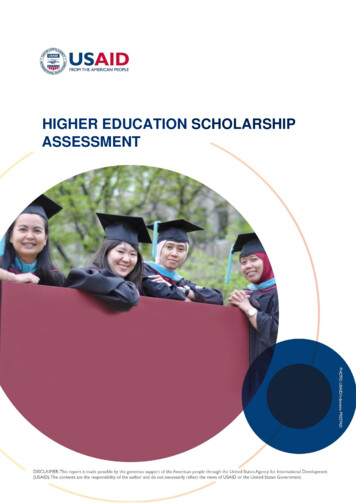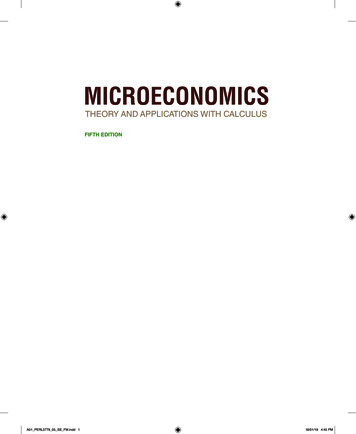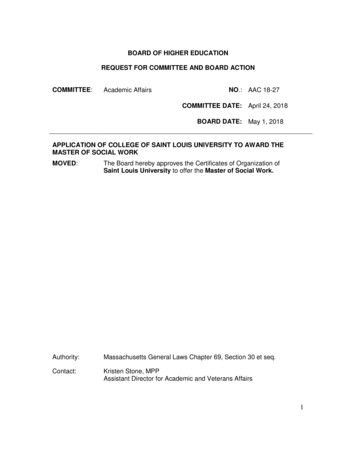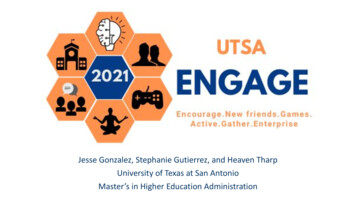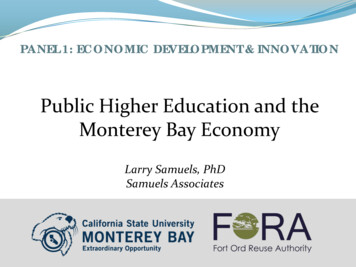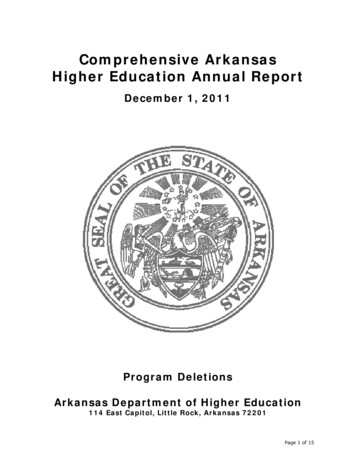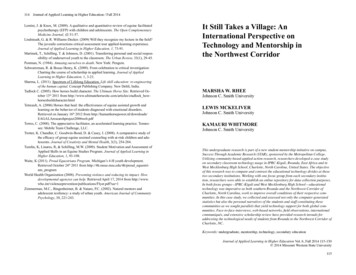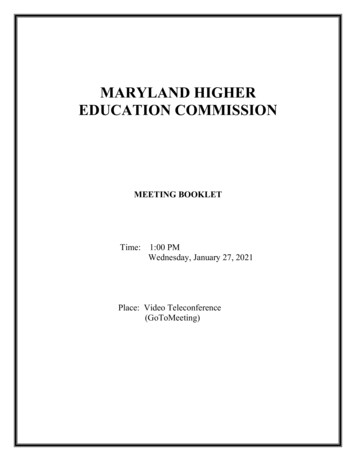
Transcription
MARYLAND HIGHEREDUCATION COMMISSIONMEETING BOOKLETTime:1:00 PMWednesday, January 27, 2021Place: Video Teleconference(GoToMeeting)
Maryland Higher Education CommissionAndrew R. Smarick, ChairDonna M. Mitchell, Vice ChairSenchal D. Barrolle, Esq.Vivian S. Boyd, Ph.D.Lewis R. Brown, Ed.D.James E. ColemanVera R. Jackson, Ph.D.Charles McDaniels, Jr.Sydney Miller, Student CommissionerJames B. Sellinger, Sr.Mary Pat Seurkamp, Ph.D.John W. Yaeger, Ed.D.James D. Fielder, Jr., Ph.D.SecretaryLawrence J. Hogan, Jr.GovernorBoyd K. RutherfordLt. Governor
Larry HoganGovernorBoyd K. RutherfordLt. GovernorAndrew R. SmarickChairJames D. Fielder, Jr., Ph. D.SecretaryMaryland Higher Education CommissionMeeting AgendaTIME: 1:00 p.m.WednesdayJanuary 27, 2021PLACE: Video Teleconference(GoToMeeting)PageCall to OrderActionItemChair’s and Secretary’s RemarksCommission Minutes Approval .1 December 16, 2020Commissioner Committee UpdatesDepartment of Finance and AdministrationOffice of Finance Policy – Mr. Geoffrey NewmanFY 2023 Community College Construction Grant Program:State and Local Cost-Sharing Formula – Mr. Daniel Schuster .6Department of Academic Affairs – Dr. Emily DowFinal Policy Change – Rescinding Restriction on Medical Assistant andNursing Assistant Programs at Private Career Schools – Ms. Trish Gordon McCown 8Classification of Nonpublic Institutions of Higher Education,Initial Reporting Year (CY 2019) – Ms. Trish Gordon McCown 112021-2025 State Plan Update – Dr. Emily DowAdjournment*The next Commission meeting is on Wednesday, February 24, 2021 @ 1:00 PM.MARYLAND HIGHER EDUCATION COMMISSION6 N. Liberty Street 10th Floor Baltimore, MD 21201T 410.767.3300 800.974.0203 F 410.332.0270 TTY for the Deaf 800.735.2258 www.mhec.maryland.gov*
Maryland Higher Education CommissionMeeting MinutesDecember 16, 20201:00 p.m.The Maryland Higher Education Commission (MHEC) met on Wednesday, December 16, 2020via video teleconference (GoToMeeting).Commission members present:Andrew R. Smarick, ChairSenchal D. Barrolle, Esq.Vivian S. Boyd, Ph.D.Lewis R. Brown, Ed.D.James E. Coleman (arrived at 1:45 PM)Vera R. Jackson, Ph.D.Charles McDaniels, Jr.Sydney Miller, Student CommissionerDonna M. MitchellMary Pat Seurkamp, Ph.D.John W. Yaeger, Ed.D.Commission members not present:James B. Sellinger, Sr.Staff members present:James D. Fielder, Jr., Ph.D.Geoffrey NewmanKaren King-SheridanBarbara Schmertz, Ph.D.Sarahita Wyatt-PaigeAlexia Van OrdenBryson BarksdaleJacqueline CadeEmily A. A. Dow, Ph.D.Jennifer KatzTrish Gordon-McCownTavon VinsonLee TowersSoma KediaLyndsay BatesGlenda AbneyCall to OrderThe meeting was called to order by Chair Smarick at approximately 1:01 p.m. A meetingquorum was established with ten of the twelve members present at that time.Election of Vice ChairCommissioner Yaeger nominated Commissioner Mitchell to serve as Vice Chair of theCommission. Commissioner McDaniels seconded the motion. Chair Smarick asked if therewere other nominations. There were none, and there was no discussion. The vote wasunanimous.1
Secretary’s RemarksSecretary Fielder thanked the staff for their work during this time, as well as for their flexibilityin moving from working in-person to working remotely. He also welcomed Chair Smarick andCommissioner Brown who was appointed very recently by Governor Hogan to serve on theCommission. Commissioner Brown introduced himself briefly, sharing that he had served inthe U. S. Army for 25 years and was now currently working for the U. S. Department ofHomeland Security.Chair’s RemarksChair Smarick thanked Commissioner Brown for his future service and Vice ChairwomanMitchell for her willingness to serve. He also thanked the Commissioners for their work.Approval of Minutes – Action ItemThere was a motion by Commissioner Seurkamp and a second by Commissioner Jackson forapproval of the minutes from the October 28, 2020 open session, October 28, 2020 closedsession, and the November 18, 2020 meeting. The motion was approved unanimously.Education Policy CommitteeChair Smarick recognized Dr. Emily Dow (Assistant Secretary for Academic Affairs) whoreported that a recent institutional request has led MHEC to review its by-laws. The institution isrequesting a waiver of faculty resources, which must be brought before the Education PolicyCommittee. As this Committee does not currently exist, it should be reinstated. Dr. Dowreferred to Article VI on Commission Committees, particularly Section 3 on the EducationPolicy Committee. One of our current committees, the Program Review Committee, doessimilar work. The by-laws also stipulate that there must be five members on the EducationPolicy Committee.Commissioner Seurkamp motioned that the Education Policy Committee replace the ProgramReview Committee and be formally established. Commissioner Boyd seconded the motion.Chair Smarick and Commissioner Seurkamp both volunteered to serve on the committee.(Members would also include current members of the Program Review Committee,Commissioners Yaeger, Boyd and Barrolle.) The motion was approved unanimously.Commissioner Committee UpdatesThere were no Commissioner Committee updates provided.Office of Research and Policy Analysis – 2020 Opening Fall Enrollment – Information ItemChair Smarick recognized Dr. Barbara Schmertz, Director of the Office of Research and PolicyAnalysis, who introduced Ms. Alexia Van Orden, Research & Policy Analyst. Ms. Van Ordenpresented the report on 2020 Opening Fall Enrollment in dashboard format, which provides a2
preliminary snapshot view of enrollments at Maryland higher education institutions. These dataare based upon enrollment reports submitted by institutions to the Maryland Higher EducationCommission, and include enrollments for all students enrolled for the fall term prior to October15, 2020. The dashboard https://bit.ly/MHEC2020 OpeningFallEnrollment also includes a briefoverview of how changes in enrollment at Maryland institutions may correlate with preliminarynational data obtained from National Student Clearinghouse. Early national data have shownacross-the-board enrollment declines across nearly all segments and enrollment types. Marylanddata generally mirror national trends.Total enrollment (undergraduate and graduate students) statewide declined 1.6%. Undergraduatestudent enrollment decreased 2.4% statewide, and graduate student enrollment increased 1.9%statewide.Review Meeting Regarding a Proposal of Notre Dame of Maryland University toImplement a Physician Assistant (PA) ProgramChair Smarick recognized Ms. Jennifer Katz, Principal Counsel, who will facilitate the reviewmeeting. Ms. Katz advised the Secretary that he will present first and be given 30 minutes,which will be divided between his initial presentation and any responsive remarks.Chair Smarick recognized Secretary Fielder who welcomed all guests and explained that theNotre Dame of Maryland University (NDMU) proposed a Physician Assistant (PA) program,which he subsequently approved. There are four PA programs in Maryland. Towson University(TU) and University of Maryland Eastern Shore (UMES) objected to the approval and requestedthe Commission to conduct a review meeting. Frostburg State University and the University ofMaryland, Baltimore are the two other schools. There were concerns by the objectinginstitutions regarding the duplication of clinical placement sites and the overall shortage offaculty. In his analysis, the Secretary found that there is no evidence that clinical placement sitesfor existing programs would be reduced. Additionally, there is a considerable distance betweenUMES and NDMU. Also, there is a workforce need for Physician Assistants in Maryland. (TheBureau of Labor Statistics projects much faster than average (31%) job growth for PhysicianAssistants.) Furthermore, he found that existing programs do not have the independent ability toincrease capacity (without obtaining approval from ARC-PA, the one national accreditor).Therefore, the workforce need cannot be met by the existing programs.Commissioner Boyd asked if students from surrounding states can seek clinical placements inMaryland. Secretary Fielder answered that out-of-state institutions pay a fee to Marylandclinical placement sites.Chair Smarick recognized Towson University’s President Kim Schatzel who thanked theCommission for the opportunity to present. President Schatzel shared that they have beenoffering their PA program since 2001. Their main objections to NDMU’s program include thedifficulty in obtaining clinical sites, as NDMU’s list has 4 overlapping sites. There is also thedifficulty in recruiting and retaining qualified PA faculty due to competition from the newprogram. Additionally, Towson University (TU) is approximately 3 miles from NDMU.Moreover, TU has the capacity to increase the number of PAs that they graduate.3
Commissioner Boyd asked what percentage of TU’s students do not obtain clinical placements.Dr. Lisa Plowfield, the Dean of the College of Health Professions, replied that TU works withtheir students until they find them placements. Chair Smarick also asked how a school canincrease the number of clinical sites. Dean Plowfield answered that they increase the number ofsites by recruiting new preceptors.Chair Smarick recognized UMES’s President Heidi Anderson who thanked the Commission forthe opportunity to present. President Anderson noted that theirs is a relatively new program,having started their first class of students in August 2020. Dr. Rondall Allen, the Dean of theSchool of Pharmacy and Health Professions, stated that one of their greatest objections was dueto the difficulty in obtaining clinical placements. Overlapping sites will be inevitable.Recruiting and retaining faculty will also be a challenge, as applicants sometimes lackexperience in teaching and administration. Lastly, President Anderson remarked that UMES isonly one of four Historically Black Colleges & Universities nationwide that is approved to offera PA program.Chair Smarick recognized Secretary Fielder for any responsive remarks. Secretary Fieldernoted that some of the material provided by TU today regarding their clinical sites is newinformation that was not previously submitted. He also expressed that MHEC continues to bestrongly supportive of UMES’s PA program.Chair Smarick recognized the representatives from Towson University for any responsiveremarks. Dean Plowfield emphasized that TU has demonstrated the duplicative nature ofNDMU’s program, which would cause potential harm to their students. Not fully having theneeded resources, due to duplication, would mean having to decrease the number of studentsthey could accept. Dr. Melanie Perreault, Provost and Executive Vice President of Student andAcademic Affairs, added that they have an existing program that, if permitted to, would be ableto expand faster. Secretary Fielder asked why they have not made a previous attempt to growtheir program, being aware of the workforce shortage. Dean Plowfield responded that, in thepast, they were able to add 10 students from UMES and accommodate them successfully.Additionally, with ARC-PA (the accrediting body), you can only make the request to increasecapacity when your program is due for re-accreditation. Commissioner Seurkamp asked if theyhave discussed with ARC-PA their desire to expand their program. Dean Plowfield answeredthat they did not make an official request, but ARC-PA is aware that they could handle anypotential increase.Chair Smarick recognized the representatives from the University of Maryland Eastern Shorefor any responsive remarks. President Anderson informed everyone that UMES will beapproaching ARC-PA when the time is right about expanding their program. Furthermore, anew School of Health Professions building is under construction and will open in Fall 2022.Additionally, they will be looking for new clinical sites. Lastly, she remarked that, as a trainedpharmacist, she sits on a pharmacy accrediting board nationally. Whenever a new program isproposed, they rely on the states’ higher education commissions to control the number of clinicalsites. This piece—the “throughput”—needs to be taken care of before the output can beincreased.4
Vice Chair Mitchell asked a question of both schools, if they have waitlists of students theycannot support, either now or before. Dean Allen responded for UMES, sharing that theycurrently have over 400 applicants, so they anticipate that they will have a waitlist, as in the past.Dean Plowfield responded for TU, noting that many students apply to several schools at once.TU typically interviews over 100 applicants for just 36 seats. Therefore, they do maintain awaitlist in order to be certain of filling every seat every semester.Chair Smarick welcomed President Marylou Yam of Notre Dame of Maryland University whothanked the Commission for the opportunity to present. Representing the proposing institution,she noted three primary arguments:1. TU and UMES have failed to provide detailed data and information supporting thereasons for the objection. Furthermore, TU and UMES provided little to no evidence tosubstantiate how NDMU’s proposed PA program would cause demonstrable harm.2. In the factors to be considered to determine whether unreasonable program duplicationexists, COMAR does not include an examination of the availability of fieldwork sites orfaculty as criteria for consideration. Rather, COMAR 13B.02.03.09(A) places emphasison examining workforce demand information to determine if a program is to beconsidered reasonably or unreasonably duplicative.3. Market demand for the proposed PA program outweighs any program duplicationconcerns, including consideration of the availability of fieldwork sites and faculty. Theirprogram is a case of educationally justified, necessary, and reasonable duplication.President Yam acknowledged that the programs are similar, and there is bound to be overlap.However, another trait which distinguishes NDMU’s program is their ability to offer a privateeducation in a faith-based environment.Commissioner Yaeger asked NDMU how they plan to address the issue of recruiting andretaining faculty. President Yam noted that it was a problem all across the board. She sharedthat their program will encourage students to learn about higher education and the option toteach. Additionally, the faith-based environment that they offer is likely to be a special draw fornot only students, but faculty as well.Secretary Fielder made a point of clarification in response to NDMU’s assertion that COMARdoes not provide for an examination of the availability of fieldwork sites or faculty as criteria forconsideration. However, when considering a proposed program, MHEC must ensure that certainresources are available, such as fieldwork sites and faculty, in order for the program to besuccessful. Hence, an examination of these factors is critical.Chair Smarick made a motion to enter into a closed session and Vice Chair Mitchell secondedthe motion. The motion was approved unanimously.AdjournmentThe meeting adjourned at approximately 3:18 p.m.5
Larry HoganGovernorBoyd K. RutherfordLt. GovernorAndrew R. SmarickChairJames D. Fielder, Jr., Ph. D.SecretaryMEMORANDUMDATE:January 27, 2021TO:Maryland Higher Education CommissionFROM:James D. Fielder, Jr., Ph.D.SUBJECT:FY 2023 Community College Construction Grant Program: State and Local CostSharing FormulaSTAFF:Geoffrey F. NewmanDaniel D. SchusterThe Community College Construction Grant Program provides State assistance for theconstruction and improvement of facilities at community colleges. This grant funds theconstruction of major new facilities, renovation of existing facilities, and improvements tocampus infrastructure.The level of State participation in capital projects for the community colleges is determined bytwo criteria: the portion of the project that meets the space eligibility requirements for Statesupport, and the State and local cost-sharing formula prescribed in statute and calculated by theMaryland State Department of Education (MSDE). MSDE uses this cost-sharing formula tocalculate the State’s share in providing financial assistance for public education. The formula isbased on a current expense calculation that considers the enrollment of students in elementaryand secondary schools and county wealth (e.g. net taxable income, the assessed valuation of realproperty, and the assessed value of personal property).Based on this cost-sharing formula, the State contributes between 50 percent and 70 percent ofthe eligible costs of a project for single-county-operated community colleges and 75 percent ofthe eligible costs of a project for regional community colleges. The table on the next page showsthe percentage of State share for newly introduced projects in the FY 2023 community collegecapital budget request.MARYLAND HIGHER EDUCATION COMMISSION6 N. Liberty Street 10th Floor Baltimore, MD 21201T 410.767.3300 800.974.0203 F 410.332.0270 TTY for the Deaf 800.735.2258 www.mhec.maryland.gov6
Community College Capital Grant Program: Percentage of State Share: FY 2023Allegany College of Maryland70.2%Garrett Community College50.0%Anne Arundel Community College50.0%Hagerstown Community College65.4%Carroll Community College50.9%Harford Community College53.1%Cecil Community College59.0%Howard Community College50.0%Chesapeake College (Regional)75.0%Montgomery College50.0%College of Southern Maryland(Regional)75.0%Prince George’s CommunityCollege59.3%Community College of BaltimoreCounty50.0%Wor-Wic Community Col.(Regional)75.0%Frederick Community College55.7%Source: Maryland State Department of Education, FY 2021 State Aid Calculations ReportRECOMMENDATION: This item is for informational purposes only.MARYLAND HIGHER EDUCATION COMMISSION6 N. Liberty Street 10th Floor Baltimore, MD 21201T 410.767.3300 800.974.0203 F 410.332.0270 TTY for the Deaf 800.735.2258 www.mhec.maryland.gov7
Larry HoganGovernorBoyd K. RutherfordLt. GovernorAndrew R. SmarickChairJames D. Fielder, Jr., Ph. D.SecretaryMEMORANDUMDATE:January 27, 2021TO:Commissioners, Maryland Higher Education CommissionFROM:Emily A. A. Dow, Ph.D., Assistant Secretary of Academic AffairsSTAFF: Trish Gordon-McCown, Director of Academic AffairsSUBJECT:Final Policy Change – Rescinding Restriction on Medical Assistant and NursingAssistant Programs at Private Career SchoolsEffective February 1, 2021, the Maryland Higher Education Commission will rescind theprogram restrictions for Medical Assistant/Assisting and Certified Nursing Assistant(Northwestern Maryland region). This decision was made in response to our recent call forpublic comments and feedback regarding the current restrictions for specific programs offered atprivate career schools in October 2020. As stated in our previous announcement, MHEC placeda restriction on Medical Assistant/Medical Assisting and Certified Nursing Assistant programsoffered at a private career school that do not meet the regulatory requirement for market demand(COMAR 13B.01.01.05).The initial determination for restrictions on these programs was made in 2015 using data andreports regarding Maryland’s workforce supply and demand. At the time, these reportsdemonstrated there was limited or no job market demand for graduates of these programs andthat there was a volume of academic programs for these fields that outnumbered the potentialemployment opportunities. However, in light of several recent school closures that offered theseprograms and the current COVID health pandemic requiring the immediate need for skilledhealthcare workers, we determined these programmatic restrictions could no longer besubstantiated.We have collaborated with multiple state agencies including the Maryland Department ofHealth/Board of Nursing (MBON) and Maryland Department of Labor to determine the currentmarket demand for healthcare wo
Jan 27, 2021 · Notre Dame of Maryland University (NDMU) proposed a Physician Assistant (PA) program, which he subsequently approved. There are four PA programs in Maryland. Towson University (TU) and University of Maryland Eastern Shore (UMES) objected to the approval
